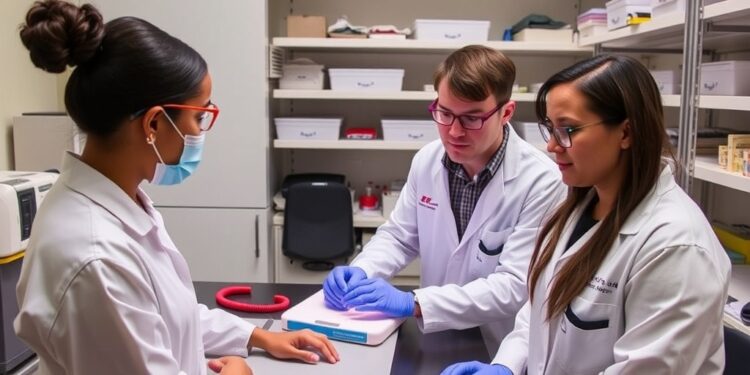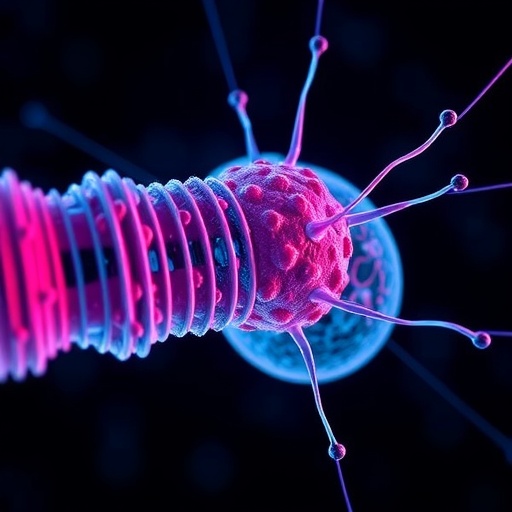In a groundbreaking development, scientists at the University of Minnesota, alongside the Midwest Antiviral Drug Discovery (AViDD) Center, have made a significant stride in the fight against one of the world’s deadliest diseases, Ebola virus disease (EVD). Characterized by an alarmingly high fatality rate of approximately 50%, Ebola has long posed a significant public health threat, particularly in certain regions of Africa. The research team’s recent innovation, the creation of nanobody-based inhibitors targeting the Ebola virus, opens new avenues in the quest for effective treatments against this lethal pathogen.
Nanobodies, which are small, single-domain antibodies derived from animals such as alpacas, have emerged as a potent tool in the development of antiviral therapies. Their diminutive size allows them to penetrate intricate folds and hidden regions of viruses, enabling them to bind to therapeutic targets that larger antibodies cannot access. This unique attribute was harnessed during the COVID-19 pandemic, when the team successfully developed nine different nanobodies to neutralize the SARS-CoV-2 virus. Now, they have redirected their expertise and novel nanobody technology towards the development of two new inhibitors tailored specifically for the Ebola virus: Nanosota-EB1 and Nanosota-EB2.
The dual mechanisms of action exhibited by Nanosota-EB1 and Nanosota-EB2 pave the way for a multifaceted approach against the Ebola virus. The Ebola virus employs sophisticated strategies to evade the immune system; it camouflages its attachment proteins beneath a protective layer, rendering them inaccessible to standard immune responses. Nanosota-EB1 intervenes by preventing this protective layer from unraveling, effectively halting the virus’s ability to bind to human cells. Concurrently, Nanosota-EB2 targets a crucial component of the Ebola virus responsible for facilitating entry into human cells. By disrupting the viral entry process, Nanosota-EB2 significantly curtails the virus’s ability to replicate and spread.
Laboratory tests conducted on mice infected with the Ebola virus have showcased the potent efficacy of these nanobody inhibitors, particularly Nanosota-EB2, which demonstrated a marked improvement in survival rates. The implications of these findings extend beyond immediate treatment protocols for Ebola; they signify a critical advancement in antiviral drug development methodologies, particularly for other virulent viruses within the same family, such as Sudan virus and Marburg virus. The adaptability of these nanobodies offers a promising framework for tackling emerging viral threats and enhancing therapeutic tools against viral outbreaks.
The research team, led by Dr. Fang Li, a prominent pharmacologist and co-director of the Midwest AViDD Center, included a diverse group of scholars and specialists. This ensemble of talent, comprising graduate students, research scientists, and assistant researchers, illustrates the collaborative effort required to address complex medical challenges through innovative scientific inquiry. Their collective work drew support from the National Institutes of Health (NIH), further underscoring the importance of federal investment in research aimed at combatting infectious diseases.
Publishing their findings in the esteemed journal PLOS Pathogens illustrates the research’s significance within the scientific community. The title “Discovery of Nanosota-EB1 and -EB2 as Novel Nanobody Inhibitors Against Ebola Virus Infection” aptly encapsulates the core achievement of the study. As global attention to infectious disease research intensifies, the scientific community eagerly anticipates future studies to validate these findings and explore the applicability of nanobody technology across a spectrum of viral infections.
As the research progresses, it is crucial to emphasize that the development of successful therapeutic agents entails extensive testing and validation before they can be utilized in clinical settings. The road from experimental study to real-world application is fraught with rigorous regulatory standards and considerations regarding efficacy and safety. Nevertheless, the prospect of deploying nanobody-based therapies offers hope, particularly for regions where Ebola outbreaks have historically wreaked havoc on communities and health systems.
The research showcases the importance of interdisciplinary collaboration in addressing pressing public health concerns. It combines aspects of molecular biology, pharmacology, and translational medicine, emphasizing how diverse expertise can be unified to yield innovative solutions to global health threats. This integrative approach serves as a model for future research initiatives aiming to harness evolutionary biology for pharmaceutical advancements.
Furthermore, the patent applications for Nanosota-EB1 and Nanosota-EB2 represent an essential step in protecting intellectual property and promoting investment in the commercialization of these therapeutic innovations. By claiming ownership of these significant discoveries, the researchers not only safeguard their contributions but also create opportunities for partnerships with biotechnology firms and pharmaceutical companies. Such collaborations can expedite the development and testing processes, inevitably delivering life-saving treatments to those who need them most.
Moving forward, the University of Minnesota’s research team envisions a trajectory whereby nanobody technology evolves concurrently with modern virology. By iterating on their existing designs and continuing to probe the possibilities of nanobody capabilities, they aim to stay ahead of viral mutations and shifts that often challenge standard treatment modalities. Their work signifies a decisive step in redefining how researchers and clinicians approach viral infections, adapting to evolving pathogens with agility and precision.
This momentum in nanobody research amplifies the broader discourse on how emerging technologies can augment traditional medical practices. It encourages a re-evaluation of existing methodologies and prompts a discussion on the necessity of innovative thinking in the face of persistent global health challenges. Highlighting the creative interplay between technology and biology, the findings from the University of Minnesota may inspire the next generation of virologists and therapeutic developers to explore the potential lying within unconventional approaches to disease intervention and prevention.
As the world grapples with both old and novel viral threats, research like that conducted by Dr. Fang Li and his colleagues becomes paramount. It is a reminder of the critical need for sustained investment in science and health research, ensuring that we remain prepared to tackle the complexities of infectious diseases both now and into the future. With innovative solutions like Nanosota-EB1 and Nanosota-EB2 on the horizon, there is a renewed sense of optimism regarding our ability to outpace virulent pathogens and protect global health.
Subject of Research: Cells
Article Title: Discovery of Nanosota-EB1 and -EB2 as Novel Nanobody Inhibitors Against Ebola Virus Infection
News Publication Date: 23-Dec-2024
Web References: https://journals.plos.org/plospathogens/article?id=10.1371/journal.ppat.1012817
References: NIH Grant U19AI171954
Image Credits: N/A
Keywords: Ebola virus, nanobodies, antiviral therapy, Nanosota-EB1, Nanosota-EB2, viral infections, pharmacology, public health





